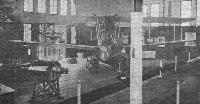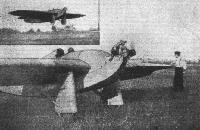Фотографии
-
Britain in the Dutch East Indies: A Vickers Viking amphibian flying-boat at the aircraft section of the Netherlands Indies Fair at Bandoeng (Java). On the same stand may be seen a Napier "Lion" engine.
Самолёты на фотографии: Vickers Viking / Type 54 - Великобритания - 1919
-
THE BARLING BOMBER: Three-quarter front view of this 120-ft.-span giant, which is fitted with six 400 h.p. Liberty engines.
Самолёты на фотографии: Engineering Division NBL1 / Barling Bomber - США - 1923
-
The Barling Bomber: A view of the machine, taken from the air, in flight during its maiden trip on August 22. Lieuts. Harold R. Harris and M. S. Fairchild piloted the machine, and Douglas Culver, McCook Field mechanic, was in charge of the engines, whilst Walter H. Barling was passenger.
Самолёты на фотографии: Engineering Division NBL1 / Barling Bomber - США - 1923
-
THE BARLING BOMBER: Some details: 1. An internal view of the fuselage. 2. One of the engine mountings. 3. The engineer's controls. 4. The bomber's compartment.
Самолёты на фотографии: Engineering Division NBL1 / Barling Bomber - США - 1923
-
THE BARLING BOMBER: Rear view of the machine.
Самолёты на фотографии: Engineering Division NBL1 / Barling Bomber - США - 1923
-
Barling NBL-1 Bomber. 6-400 hp. Liberty Engines
Самолёты на фотографии: Engineering Division NBL1 / Barling Bomber - США - 1923
-
The latest Fokker: This one-and-a-half 'plane is fitted with a Napier "Lion" engine, and has reached an altitude of 8,500 metres with a load of 1,000 lbs. Mijnheer Fokker claims that it is not essentially different in principle from the 1915 machine.
Самолёты на фотографии: Fokker D.XIII - Нидерланды - 1924
-
THE KINNER "AIRSTER" SPORTPLANE: Two views showing, above, a three-quarter front view, and, below, the fuselage.
Самолёты на фотографии: Kinner Airster - США - 1920
-
THE KINNER "AIRSTER" SPORTPLANE: Three-quarter rear view.
Самолёты на фотографии: Kinner Airster - США - 1920
-
CIVIL AVIATION IN CZECHO-SLOVAKIA: The single-engined Ae.10, designed and built by the "Aero" works of Prague, has succeeded in carrying no less than 17 passengers, who are shown in the inset.
Самолёты на фотографии: Aero A.10 - Чехословакия - 1922
-
THE AMERICAN AROUND-THE-WORLD FLIGHT: One of the four Douglas "World Cruisers" (400 h.p. Liberty) which will be used in the U.S. Army Air Service around-the-world attempt next spring.
Самолёты на фотографии: Douglas DWC / World Cruiser - США - 1923
-
AN AMERICAN TORPEDO-SEAPLANE: A successful twin-float tractor biplane, 400 h.p. Liberty, for torpedo carrying, a number of which have been built up for the U.S. Naval Air Service by the Davis Douglas Company.
Самолёты на фотографии: Douglas DT - США - 1921
-
THE FOKKER S.III: Fitted with a 90 h.p. Curtiss engine, this machine is intended for school work. It is of usual Fokker construction, with steel tube welded fuselage and all-wood wings. The "Fokker Bulletin" states that recently Mijnheer Fokker took up as passenger in this machine General Festing, and gave a demonstration of stalling at low heights. It will be remembered that it is claimed for the Fokker machines that they remain controllable at angles far above the stalling angle.
Самолёты на фотографии: Fokker S.II / S.III / S.IV - Нидерланды - 1922
-
A flying visitor from America: Lawrence Sperry, the well-known American pilot, with his wife, father, and aerial Flyabout, which he brought with him on his sightseeing trip to Europe. He is still in this country, and has already made good use of his little 'plane, which is known as the Sperry Messenger, and is fitted with a 60 h.p. Wright L-4 radial engine.
Самолёты на фотографии: Sperry M-1 Messenger - США - 1920
-
Регистрационный номер: A-6525 One of the U.S. Navy's collapsible submarine-'planes, the Martin M.S.1, fitted with a 60 h.p. Wright L-4 radial engine. This machine is easily packed away in a submarine and as easily erected, when the submarine comes to the surface and it is desired to make an aerial survey. The 'plane is assembled on the submarine's deck, and when all is ready, the submarine dives, leaving the 'plane on the water ready to take off.
Самолёты на фотографии: Martin MS-1 - США - 1923
-
THE DE MONGE TYPE 72: This photograph shows a wind tunnel model of the machine. The engines will be Lorraine-Dietrichs of 375 h.p. each. Before building the large machine M. de Monge has had a twin-engined light monoplane built to test out the general arrangement.
Самолёты на фотографии: De Monge Type 7.4 - Франция - 1923
-
The Ds Monge "Light" Monoplane: Some constructional details. On the left, the mounting of the two Anzani engines, the undercarriage, and the root of the end section of a wing. On the right: Above, a portion of a wing, showing false spar for aileron, and wing strut attachment. Below, a typical wing rib. Inset, the hinge of the divided wheel axle.
Самолёты на фотографии: De Monge Type 7.4 - Франция - 1923
-
De Monge Twin engined "Light" Plane 2-35 hp. Anzani Engines
Самолёты на фотографии: De Monge Type 7.4 - Франция - 1923
-
Регистрационный номер: O-BAFG The King of the Belgians Inspecting Light 'Planes: Our photograph shows, left to right, Major Smeyers, Commander of the Belgian Air Force, King Albert, Lieut. Baron Kervyn de Lettenhove, Lieut. V. Simonet, and M. Poncelet, the designer of the light 'planes that took part in the Lympne competitions.
Самолёты на фотографии: Poncelet Castar / Vivette - Бельгия - 1921
-
Регистрационный номер: O-BAFF BELGIAN LIGHT 'PLANES: The Jullien S.A.B.C.A. is a pure cantilever monoplane with 500 c.c. Douglas engine. On the left the machine on the ground, and on the right it is seen in flight over Evere aerodrome.
Самолёты на фотографии: SABCA Jullien SJ.1 - Бельгия - 1923
-
Belgian Light 'Planes: The E.M.A. biplane is fitted with an 1,100 c.c. Anzani engine. This machine has reached an altitude of 4,000 ft.
Самолёты на фотографии: EMA biplane - Бельгия - 1923
-
A FOKKER MACHINE OF 1915: This little biplane, with rotary engine, was the first cantilever machine, and Fokker had great difficulty in convincing the German authorities that this form of wing could be strong enough.
Самолёты на фотографии: Fokker V1 / V2 / V3 - Германия - 1916
-
THE LINCOLN-STANDARD L.S.5 COMMERCIAL AEROPLANE: Three-quarter rear view of tbe complete machine, showing the semi-enclosed cabin, seating four passengers.
Самолёты на фотографии: Lincoln-Standard LS.5 - США - 1923
-
THE LINCOLN-STANDARD L.S.5 COMMERCIAL AEROPLANE: Three close-up views: on the left, the 180 h.p. Hispano-Suiza engine in situ; centre, the passengers' and pilot's cockpits; right, the landing gear.
Самолёты на фотографии: Lincoln-Standard LS.5 - США - 1923
-
THE LAIRD LIMOUSINE: Three-quarter rear view of the complete machine. It has a totally enclosed cabin seating five passengers, and is fitted with a 300 h.p. 12-cylinder Packard engine.
Самолёты на фотографии: Laird Limousine - США - 1921
-
The Pegna "Rondine." Photograph shows undercarriage and engine mounting. Inset, the machine in flight.
Самолёты на фотографии: Pegna Rondine - Италия - 1923
-
Pegna "Rondine" Light Monoplane 5/7 hp A.B.C. Engine
Самолёты на фотографии: Pegna Rondine - Италия - 1923
Статьи
- Flight


























